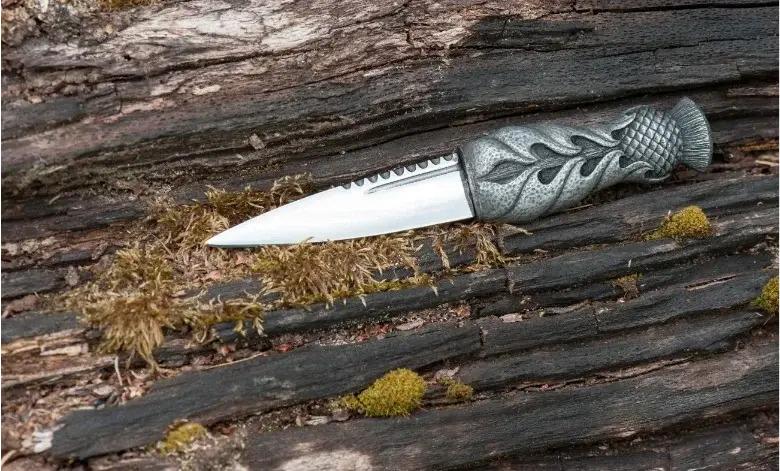Wearing a Sgian Dubh everything you need to know

The Sgian Dubh is a small, single-edged knife with a special place in Scottish culture and tradition. The name “Sgian Dubh” comes from the Gaelic words “sgian,” meaning knife, and “dub,” meaning black. Historically, this knife was concealed within the clothing, hence the term “black knife,” which signifies hidden or secret rather than its color.
Historical Origins:
The Sgian Dubh has deep roots in Scottish history. Originally, it was a practical tool for everyday tasks, such as cutting food and kindling. The knife’s small size made it easy to carry and conceal. During the 18th and 19th centuries, it became an essential part of Highland dress, symbolizing the resourcefulness and resilience of the Highland clans. Its evolution from a utility knife to a ceremonial accessory highlights its importance in Scottish heritage.
Cultural Importance
Beyond its practical uses, the Sgian Dubh carries significant cultural weight. It is an emblem of Scottish identity and pride, often passed down through generations as a family heirloom. Worn tucked into the top of the kilt hose with the handle visible, the Sgian Dubh represents transparency and trust.
This tradition stems from a time when showing one’s weapons was a gesture of peace, demonstrating that no hidden arms were present. Today, it remains a key element of formal Highland attire, worn at weddings, ceilidhs, and other cultural gatherings, continuing to symbolize Scottish tradition and honor.
Understanding the Sgian Dubh’s historical origins and cultural importance offers a deeper appreciation of this iconic Scottish accessory. Whether viewed as a practical tool or a symbol of heritage, the Sgian Dubh is a testament to Scotland’s rich and storied past.
Properly Wearing a Sgian Dubh
Wearing a Sgian Dubh correctly is essential for maintaining traditional Scottish attire. Traditionally, the Sgian Dubh is placed on the top of the kilt hose, on the outside of the right leg for right-handed individuals, and on the left leg for left-handed individuals. The handle should be visible above the top of the sock, ensuring it is easily accessible and adds to the overall aesthetic of the Highland dress.
In modern times, some wearers adapt the placement to fit personal style or comfort, sometimes angling it slightly for a unique look. It’s crucial to ensure the Sgian Dubh is securely tucked into the sock to prevent it from slipping out. Whether adhering to traditional methods or incorporating modern styles, wearing the Sgian Dubh properly showcases respect for Scottish heritage and attention to detail in Highland attire.
Choosing Between Sharp and Decorative
When selecting a Sgian Dubh, you can choose between a sharp, functional blade and a decorative, blunt one. A sharp Sgian Dubh offers authenticity and can be used as a utility knife for practical purposes, staying true to its historical roots. However, it requires regular maintenance to keep the blade in good condition.
On the other hand, a decorative Sgian Dubh with a blunt blade prioritizes safety and compliance with legal restrictions, making it ideal for public events and travel. These versions often feature intricate designs and craftsmanship, focusing on aesthetics rather than functionality.
It’s important to consider local laws regarding carrying sharp blades in public spaces to avoid any legal issues. Choosing between a sharp or decorative Sgian Dubh depends on your needs and the contexts in which you’ll wear it, balancing tradition with practicality and safety.
Traveling with a Sgian Dubh
Traveling with a Sgian Dubh, especially by air, requires careful attention to regulations and packing methods. Most airlines and airports have strict rules regarding carrying sharp objects, so checking specific guidelines before your trip is essential. Generally, a sharp Sgian Dubh must be packed in checked luggage rather than carry-on bags to comply with security regulations.
If you prefer to keep your Sgian Dubh with you, opt for a decorative version with a blunt blade to avoid complications. When packing, ensure the knife is securely sheathed and stored in a way that prevents any damage or injury. Consider using a protective case to keep the Sgian Dubh safe during transit. Following these precautions and being aware of regulations will ensure your travel with a Sgian Dubh is smooth and trouble-free.
Public Use of a Sgian Dubh
Wearing a Sgian Dubh in public requires adherence to proper etiquette and safety measures. It is a symbol of Scottish heritage and should be worn with respect. When attending formal events or gatherings, ensure the Sgian Dubh is prominently displayed in your kilt hose, with the handle visible. This traditional placement signifies openness and honesty. However, in crowded or sensitive areas, be mindful of safety.
Ensure the knife is securely sheathed to prevent accidents. If local laws or event rules restrict carrying sharp objects, opt for a decorative, blunt version to avoid legal issues. Understanding the appropriate context and maintaining a respectful demeanor when wearing a Sgian Dubh in public helps preserve its cultural significance and ensures safety for everyone.
Pairing Your Sgian Dubh
Choosing the right outfit with your Sgian Dubh enhances the knife and your overall appearance. Traditionally, the Sgian Dubh is part of a full Highland dress, which includes a kilt, sporran, kilt hose, and garter flashes. This classic ensemble is typically worn at formal events such as weddings and ceilidhs, where the Sgian Dubh adds an authentic touch.
For a modern twist, you can pair a Sgian Dubh with more contemporary outfits, such as kilts worn with casual jackets or even jeans, for a fusion of tradition and style. Ensure the Sgian Dubh complements the colors and patterns of your attire. Whether adhering to traditional dress or experimenting with modern fashion, the Sgian Dubh should enhance your outfit, reflecting heritage and personal style.
Yes, it is generally legal to wear a sgian dubh as part of traditional Scottish attire, especially at cultural events like weddings or Highland games. However, laws vary by country and jurisdiction. In the UK and Scotland, it’s acceptable in traditional contexts but carrying it in public without a legitimate reason may be restricted. Always check local regulations to ensure compliance.
The etiquette for wearing a sgian dubh includes:
- Placement: Wear it tucked into the top of your right sock, with only the hilt visible.
- Visibility: Ensure the hilt is visible but discreet.
- Events: Wear it for formal or traditional occasions like weddings, Highland games, and ceremonies.
- Respect: Handle it with respect, as it is both a weapon and a cultural symbol.
Always follow local laws and regulations regarding carrying knives in public.
The sgian dubh should be worn on the right leg if you are right-handed. If you are left-handed, it can be worn on the left leg for easier access. The knife is tucked into the top of the sock, with the hilt visible above the sock’s edge.
No, you cannot take a sgian dubh on a plane in your carry-on luggage due to security regulations prohibiting knives and sharp objects. If you need to transport a sgian dubh, you must pack it in your checked luggage, ensuring it is securely wrapped and declared if necessary, following the airline and airport security guidelines. Always check specific airline regulations before traveling.
The sgian dubh symbolizes Scottish heritage and tradition. It represents the historical practice of carrying a small knife for self-defense and utility. Worn as part of traditional Highland dress, it signifies cultural pride and respect for Scottish customs. The sgian dubh also reflects the wearer’s readiness and resourcefulness, being both a functional tool and a ceremonial accessory.
The sgian dubh is typically worn on the right leg if you are right-handed. If you are left-handed, it can be worn on the left leg for easier access. The knife is tucked into the top of the sock, with the hilt visible above the sock’s edge.
A sgian dubh typically measures around 6 to 7 inches (15 to 18 cm) in total length. The blade itself is usually about 3 to 4 inches (7.5 to 10 cm) long.
Yes, traditional sgian dubhs are sharp and functional knives, intended for practical use as well as ceremonial wear. However, some modern sgian dubhs, especially those worn primarily for ceremonial purposes, may have dull or blunt blades for safety reasons. Always check the sharpness of your sgian dubh and handle it with care.


